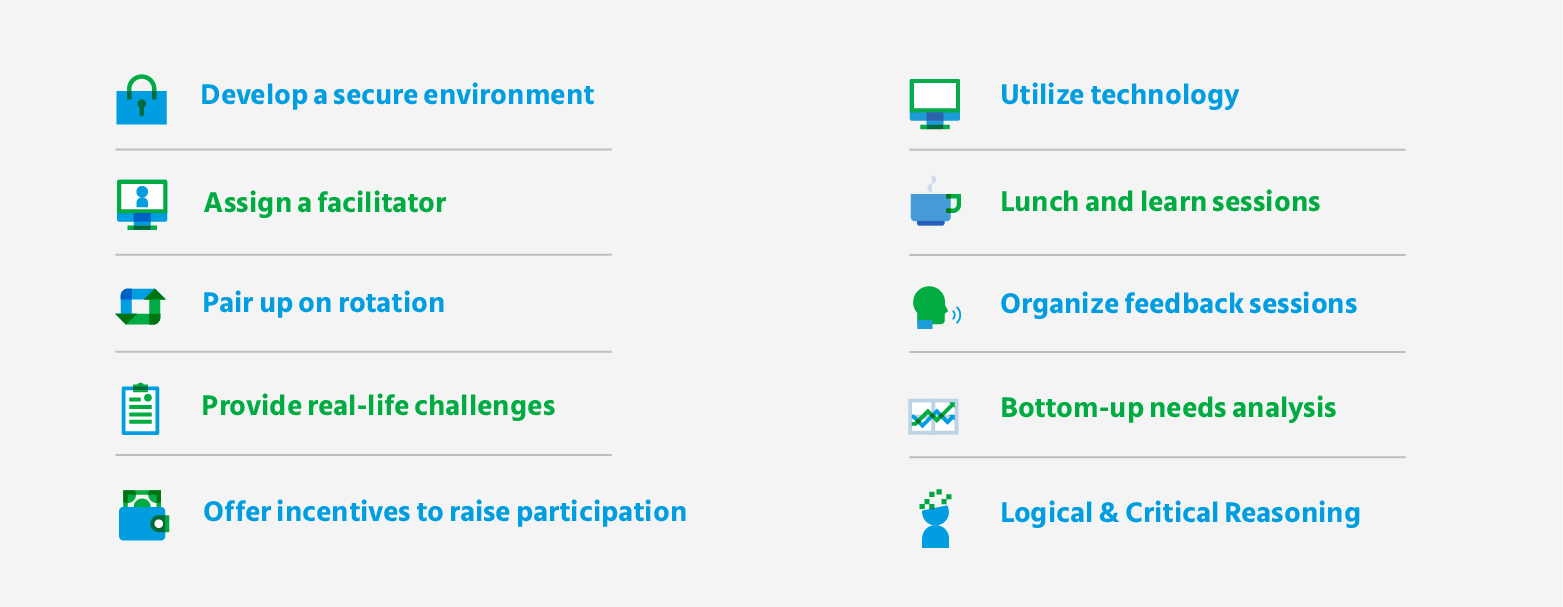
Organizations can foster peer-to-peer learning through the following strategies:
1. Develop a secure environment
The most important step is creating a secure environment where peers feel free to ask questions, raise doubts, and share feedback. And organizations can create a safe environment to promote peer-to-peer learning by enforcing the following guidelines.
No questions should be considered unimportant
- Feedback must be constructive
- Respect new ideas, opinions, and perspectives
- These guidelines will help employees bridge the skills set gap and strengthen the company’s culture.
2. Assign a facilitator
Organizations can assign a facilitator to coordinate and track the progress to encourage peer-to-peer learning. This facilitator should have prior leadership experience to create an organized rotational structure for employees. This will prevent employees from getting overwhelmed and help bring different perspectives to several processes and tasks.
3. Pair up on rotation
Organizations can pair employees with different peers to encourage the adoption of new perspectives, ideas, and solutions. Employees can get exposure to others’ skill sets, knowledge, leadership styles, and teaching methods. This peer-to-peer learning strategy will improve the interaction between different team members and departments. In addition, it will help employees learn the art of communicating with people with diverse personalities.
4. Provide real-life challenges
Organizations can pair new joiners with experienced employees who can provide real-life problems and solutions related to their jobs. As a result, new employees learn practically and develop interpersonal and soft skills during the process. It will be a two-way street rather than a one-way struggle.
5. Offer incentives to raise participation
Peer-to-peer learning involves commitment, engagement, and effort. Offering incentives to employees who actively participate and make a difference will encourage participation. It is optional to provide financial incentives but should include things to aid career progression.
Some tips for the same are:
- Use games to create a productive and competitive environment via challenges, leaderboards, and achievement prizes.
- One of the valuable methods is recognition of some type. Praise employee efforts and create a champions board to encourage others to share knowledge.
6. Utilize technology
Technology implementation is one of the critical factors in implementing peer-to-peer learning strategies. The remote working culture arrived with the Covid-19 pandemic. Providing digital learning and interactive platforms will allow participants to share ideas, teach new concepts, clarify doubts, and offer solutions. This will foster collaboration even when team members are located in different parts of the world.
7. Lunch and learn sessions
Lunch and learn sessions add to the above strategies in a social and relaxed environment. Like brainstorming sessions conducted in a natural setup without pressure, lunch and learn sessions help peers collaborate on exciting topics, engage in a group discussion, and share expertise.
While in a formal setup, employees are often hesitant to resolve doubts or ask questions, this method helps host events and discuss challenges and issues from every possible angle.
It is imperative to initially encourage motivation in such sessions with a complimentary lunch.
8. Organize feedback sessions
The facilitator must hold mandatory feedback sessions in the initial stages of peer-to-peer learning. Create a written report to improve communication and ensure constructive criticism. It will invoke practical and critical thinking in employees, scrutinizing how a task has been completed and challenges have been tackled.
9. Bottom-up needs analysis
The bottom-up needs approach is a method in which the workforce declares its learning requirements. This increases the chances of offering actual learning benefits to employees.
In reality, most businesses follow a top-down approach where the management decides L&D needs and describes learning gaps and associated goals.
Utilizing a bottom-up training method helps employees get involved in their own professional growth. This ensures the correct identification of learning gaps and appropriate peer-to-peer learning strategies for these challenges.
10. Job shadowing program
Job shadowing program involves real-life training in different job roles. The method helps employees understand job pressures, intricacies, and requirements for varied functions. As a result, cross-role empathy is developed across teams.
For example, when allowed to observe the work of an accounting or sales professional, a marketing team professional may understand their daily struggles closely. Hence, it will help each member develop empathy and respect towards different job roles, improving cross-team compatibility and collaboration.
Besides building cross-team empathy, job shadowing encourages employees to explore varied roles that may seem more relevant to them. For example, many professionals want to change careers, and job shadowing will help them judge the possibilities and feasibility of the new role.









 Behavioral Competencies
Behavioral Competencies Cognitive Competencies
Cognitive Competencies Coding Competencies
Coding Competencies Domain Competencies
Domain Competencies




































Would you like to comment?